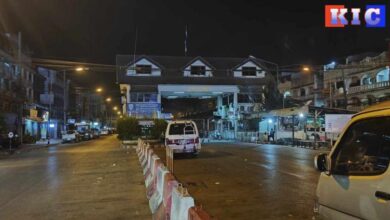Burma Army’s use of deadly airstrikes marks brutal escalation in Kachin conflict

First use of airstrikes by the government in twenty years raises prospect of increased numbers of civilian deaths in conflict areas – community groups condemned air strikes.
The Burma Army’s appalling human rights abuses, especially in the conflict zones of ethnic states is well documented by international humanitarian groups, including Human Rights Watch and Amnesty International
On 2 January 2013, the Burma Army admitted that it had launched an aerial attack on Laijayang, an area where 25,000 refugees are sheltering. Laijayang is about 11 kilometres from Laiza, the proclaimed capital of Kachin State and where the Kachin Independent Organisation headquarters is situated, and where there are a further 10,000 internally displaced people seeking refuge.
In December 2012, government troops used extensive heavy artillery, including 84mm Carl Gustaf rocket launchers, 105mm howitzers, 120mm mortars and Russian-made Mi-35 helicopters, according to local sources and the Free Burma Rangers. There has been heavy artillery shelling near civilian areas and shells have landed in neighbouring China.
Community organizations and a number of ethnic groups have united in their condemnation of the attacks by the Burma military.
According to the Women’s League of Burma (WLB), the degrading situation in Kachin State is evidence that Burma’s government is either unwilling or unable to cease human right abuses against ethnic minorities in Burma.
“There has not been a single airstrike for 20 years, but now government forces are using jet fighters and helicopters to launch attacks near civilian areas,” WLB General Secretary Tin Tin Nyo said.
“It is as clear as day: the situation is worse than ever. We ask the international community to take action against Thein Sein’s government to stop fighting, and for the refugees,” said Tin Tin Nyo
The Kachin State conflict first erupted in June 2011, when Burma’s Army broke a ceasefire agreement to attack the Kachin Independence Army (KIA), the armed wing of the Kachin Independence Organization (KIO). As many as 100,000 people have since been displaced by the conflict.
“Not only is the government not protecting civilians or stopping the Burmese troops, U Thein Sein and U Aung Min are denying human rights abuses. Now that the fighting has increased, the government troops will use this pretext to continue raping, torturing and killing.” Said Moon Nay Li.
Rape, committed rampantly in and around Kachin State, is recognised as a systemic and calculated war tactic, rather than a random act of violence. Moon Nay Li, who has documented gang rapes in Kachin State, highlighted that victims are as young as nine years old, and half of the victims in cases she documented in 2011 were killed after being raped.
In March 2012 the UN Special Rapporteur, Tomas Ojea Quintana, listed a series of ongoing human rights abuses in Burma including, “attacks against the civilian population, extrajudicial killings, internal displacement, the use of human shields, forced labour, destruction of property, and conflict-related sexual violence.”
The Ethnic Human Rights Network accused the Burma Army of using chemical weapons in the conflict. “Many people are fleeing into refugee camps that are based under the fighter jet path of the government and many children are living under the threat of chemical weapons,” the Ethnic Human Rights Network said in a public statement.
Mr Yaw Na, a spokesperson for the Ethnic Human Rights Network spoke to Karen News.
“We are disappointed that we have heard nothing from Suu Kyi or the NLD on the Kachin situation. There’s plenty of talk about development, but nothing on this conflict.”
Meanwhile, Naing Han Tha, a spokesperson for a key ethnic alliance, the United Nationalities Federal Council (UNFC) compared the attacks on the Kachin by the Burma government’s military as an attack on all ethnic people in the country.
The UNFC statement blamed the government and its military for trying to dominate and enslave ethnic nationalities.
Speaking to Karen News, Naing Han Tha said, “If the government continues its action, there could be offensives against the Shan, who bordered with the Kachin. We will consider the Kachin’s situation and discuss what we will do for our next step.”
The UNFC represent 12 major ethnic armed groups, including the Kachin Independent Organization, the Karen National Union, the New Mon State Party, the Shan State Progressive Party/Shan State Army, the Karenni National Progressive Party and the Chin National Front.




